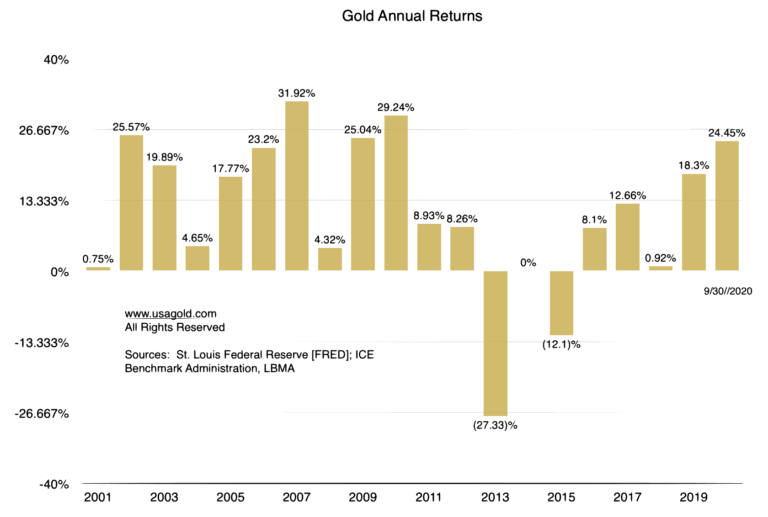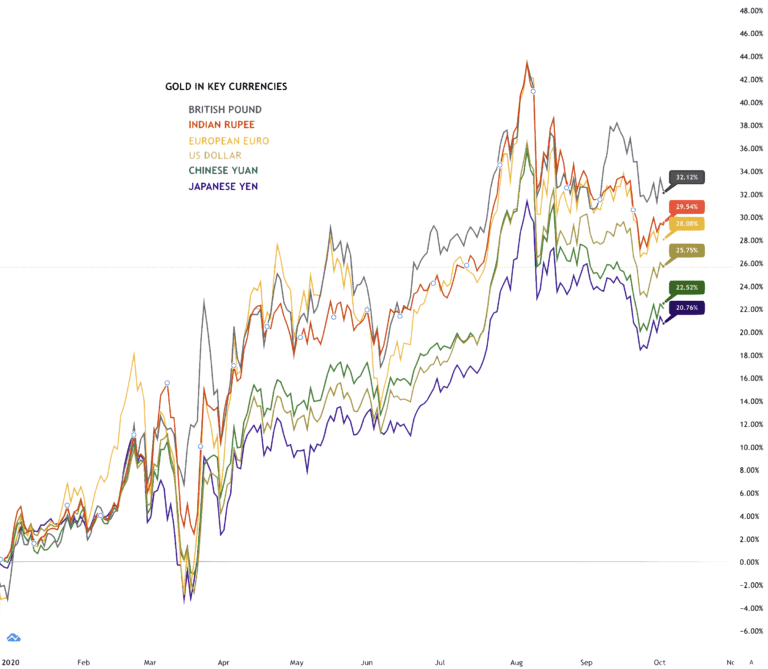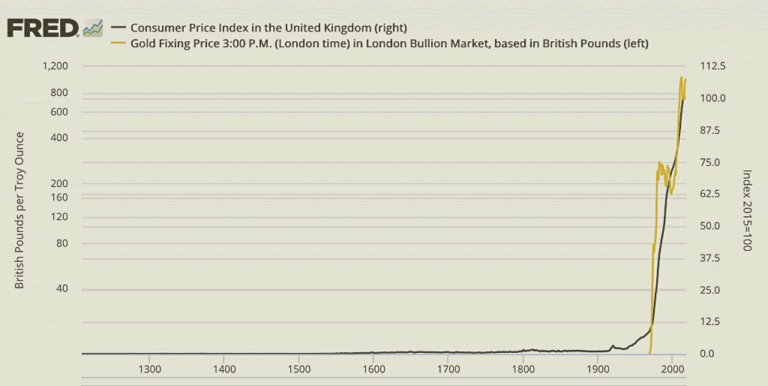A complete paradigm shift will make gold the generational trade
Commodities / Gold & Silver 2020 Oct 09, 2020 - 03:24 PM GMT‘A complete paradigm shift will make gold the generational trade’

As we turn the calendar to October, often a daunting month for financial markets, the same toxic mix that has bedeviled the global economy for most of 2020 remains in full force – the pandemic, the crippled economy, the money printing, and the disheveled politics. For its part, gold held up under the pressure of a September consolidation that threatened at one point to become a full correction, but the selling dissipated, cautious buying re-entered the market and the price went back over the $1900 mark. October always brings a sense of foreboding given its history, and we can only hope that the rest of the month will go significantly better than the start. Gold tends to move to the forefront when things go bump in the night, but then again, gold has been in the forefront for most of 2020 – prompting some analysts to proclaim the launch of a new leg in its long-term secular bull market.
Wall Street-based billionaire and financier Thomas Kaplan (who once said “I’m no insect; gold is a great way to make a lot of money.”) is among that group and expanded on the notion in a recent interview with Stansberry Research’s Daniela Cambone. Though Kaplan made his fortune in the mining business, he is also an Oxford-trained historian (with a Ph.D.) capable of putting gold’s secular bull market in the context of a longer-term cycle – one he believes has not yet reached full maturity. His comments, we think you will agree, offer a refreshing perspective at a time when it is sorely needed and when short-termism seems to dominate investor psychology.
“Let’s put it this way,” he says, “gold still remains on Wall Street and in the west probably the most under-owned, least crowded trade in the global financial markets. … The era in which gold was the asset which people loved to hate and hated to love is starting to come to an end. We’re still in the very early innings. It’s still a smart money trade as opposed to a big passive money trade but that’s about to happen.” The next leg up, he believes, will be driven by what he calls “bold-faced” names now involved in the gold business – like Buffett, El Erian, Mobius, Dalio, Gundlach, and Rogoff. (Long-time readers of this newsletter will recognize that list of notables is abbreviated.)
“The difference is this,” he says. “The market is now ready for the next leg of the gold bull market. The first leg was the one that took us up 12 consecutive years in a row regardless of whether there were inflation fears, deflation fears, whether there was a glut of oil or a shortage of oil, political stability or political instability, dollar weakness, dollar strength. It didn’t matter. Every year for 12 years gold went up. The next move is going to be a third wave, a long wave that lasts for a decade or fifteen years, maybe more … I think that you really are looking at a complete paradigm shift that will make gold the generational trade.”
From there Kaplan goes on to say that gold will reach $3000 to $5000 in the years to come – a restatement of a prediction he made several months ago before gold launched this latest leg in its bull market. As shown in the chart below, in addition to the twelve consecutive years of gains Kaplan mentions above, gold has finished higher in sixteen of the last twenty years. Gold’s 24.45% advance through the end of September is the fifth-best since 2000 and takes into account the recent consolidation from the all-time high of $2065.

Nobel laureate says ‘public should not be worried’ about the national debt
Unnoticed with everything else that is going on, the U.S. national debt just pushed over the $27 trillion mark, as we close out the federal government’s fiscal year. Since January 1, Washington has added an astonishing almost $4 trillion in red ink – a 17% increase in nine months. “When asked about the staggering number, Nobel laureate Esther Duflo told CNBC, ‘That is not something that the general public should be worried about for the time being at all.’ She continued, explaining that American credit is one of the safest assets to hold, so in a sense, it is unlikely that the government will ever have to repay this debt.”
It is difficult to believe that intelligent, highly educated people including a Nobel laureate can persuade themselves that debt – particularly a nation’s debt – does not matter. This is all politics and politics in the silly zone. If, for example, the U.S. government will never have to repay its debt, why not borrow $100 trillion this year and spend it to offset the ill-effects of the coronavirus? Why not borrow $200 trillion? $300 trillion? Debts have a due date for a reason and that reason has to do with the creditor expecting to be repaid – even in this day and age – and, by the way, with interest.
Bridgewater sees a unique role for gold in protecting portfolios
“We’ve had a few such periods of extraordinary stimulus over the past century,” says Bridgewater Associates in a recently released report, “all in times of economic depression, conflict, or both – and in all of them, gold saw triple-digit rallies that dwarf its recent run-up…In the era of fiat money, even without the explicit need to devalue against gold, the effect of reflationary policies is to devalue paper currencies relative to storeholds of wealth.” As such, gold demand is on the rise among citizen-investors around the world. Nowhere is that more evident than in the price of gold itself in the world’s top currencies, as shown in the chart below.
Since the beginning of the year, gold has risen sharply in six of the world’s top currencies – Indian rupee (+29.5%); Chinese yuan (+22.52%); U.S. dollar (+25.75%); British pound (+32.12%); European euro (+29.54%), and Japanese yen (+20.76%). The rising tide in those currencies represents concern among the citizenry of each country in the further debasement of the national currency and attendant systemic risks. (All as of 10/2/2020)
“In brief,” says Bridgewater, “in a world of ongoing pressure for policymakers across the globe to print and spend, zero interest rates, tectonic shifts in where global power lies, and conflict, gold has a unique role in protecting portfolios. The move we’ve seen in gold this year is quite modest relative to what we’ve seen in past reflationary periods, and given still depressed levels of activity globally, the need to keep reflationary policies in place will persist for some time. While gold offers no known yield, no known yield can be quite attractive when the yields on other assets are known to be terrible.” Bridgewater, the world’s largest hedge fund, is headed up by Ray Dalio, who, as many of you already know, has been a vocal advocate of gold ownership for some time now.

Chart courtesy of TradingView.com • • • Click to enlarge • • • Year to date
How much gold should you own?
Investors often ask about the percentage commitment one should make to precious metals in a well-balanced investment portfolio. Analyst Michael Fitzsimmons offered an interesting take on that subject in a recent Seeking Alpha editorial, “Assuming a well-diversified portfolio (which does include cash for emergencies),” he says, “my belief is that middle-class investors (net worth under $1 million), should own at least 5-10% in gold. I also believe that as an American investor’s net worth climbs, the higher that percentage should be because, in my opinion, he or she simply has more to lose by a falling US$. For instance, an investor with a net worth of $2-5 million might have a 15-20% exposure to gold; $10 million, perhaps a 30-40% exposure.”
The coming age of disorder
“This isn’t appealing,” writes John Authers in a recent Bloomberg Opinion piece. “Betting on a return to inflation might be a good idea. And indeed, the only period in which commodities outperformed was the stagflationary 1970s. As commodities (excluding precious metals) have been mired in a bear market for more than a decade, and have a historical tendency to move in long waves …” The stock and bond markets appear to be running out of room at the end of the rainbow and commodities look poised to take their turn at the plate. …… A stagflationary outcome is one that keeps cropping up among thinkers we happen to respect – a period like the 1970s when commodities, on the whole, did very well while stocks languished. The thing about gold and silver is that they will likely participate in a commodity boom and be at the ready for safe-haven purposes even if it doesn’t. Auther’s latest draws from the thinking of Deutsche Bank’s “veteran financial historian” Jim Reid who says we are entering the Age of Disorder – the sixth economic era since the American Civil War – and one, as its name implies, likely to be fraught with danger.
‘When money dies, gold comes into its own’
Britain’s prominent newspaper, The Telegraph, recently published a lengthy article under the eye-catching headline When money dies, gold comes into its own – eye-catching in particular for gold enthusiasts who understand the connection between eroding currency purchasing power and the price of gold. “Whatever,” writes Jeremy Warner, “the fact is that gold tends to sustain its value over time. National currencies, eroded by inflation and political manipulation, do not. …… As I say, a rising gold price reflects, above all other things, a loss of trust in the value of fiat currencies, for which there is good reason right now.”
In a separate article at The View from Our Whitehouse website, Robert Pringle formerly head of public policy for the World Gold Council and founder of Central Banking magazine, reminisces about the late 1990s sale of a large portion of Britain’s gold in the context of that article. “The sale [of a large portion of the UK’s gold holdings] was a personal decision by Gordon Brown on the advice of the Treasury mandarins who thought it would make him look ‘modern’ and of course it all came unstuck. It would plague him for the rest of his career and remains one of the great blots on his reputation.”
We recall that the British government’s argument at the time was that the gold could be swapped for currencies that drew an interest rate. How short-sighted it all seems today. At a time when major currencies are being debased aggressively and Britain is suffering the economic pain of Brexit, how comforting would it be to have that gold sitting in the national vault gathering dust at nearly $2000 per ounce? (Gold, by the way, it sold at under $300 per ounce in 1999.)
‘Dollars, yen and euros will not always glitter in a storm and they will never be mistaken for gold’
If you have an interest in the 1999 UK gold sales, you might find “Britain’s gold sales ‘a reckless act” an engaging read. It includes the complete text of an important speech delivered in the House of Commons at the time by Sir Peter Tapsell – a speech by the way that still rings with clarity today as one of the most eloquent public appeals ever made on the merits of gold ownership for both nation-states and individuals. Reprinted with the permission of the United Kingdom Parliamentary Archives, it also includes comments from other members of Parliament and those of Patricia Hewitt, Economic Secretary to the Treasury (the chief advocate other than Gordon Brown himself of swapping Britain’s gold for foreign currencies).
The entirety of Tapsell’s speech and the subsequent exchange among members of Parliament is worth a visit, but here is a brief extract to whet your appetite: “The whole point about gold, and the quality that makes it so special and almost mystical in its appeal, is that it is universal, eternal and almost indestructible. The Minister will agree that it is also beautiful. The most enduring brand slogan of all time is, “As good as gold.” The scientists can clone sheep, and may soon be able to clone humans, but they are still a long way from being able to clone gold, although they have been trying to do so for 10,000 years. The Chancellor may think that he has discovered a new Labour version of the alchemist’s stone, but his dollars, yen and euros will not always glitter in a storm and they will never be mistaken for gold.”
The title to Jeremy Warner’s article, When money dies, gold comes into its own, brings to mind a chart we run occasionally as our Chart of the Day at USAGOLD’s Daily Market Report. Nothing drives home Warner’s point better than a visual history that shows 700-years of economic stability overturned by the introduction of a fiat currency (Britain went off the gold standard in 1931.). The chart of British consumer prices is supplied by the St. Louis Federal Reserve. We took the liberty of superimposing the price of gold. This chart at a glance demonstrates convincingly that if there is such a thing as a monetary version of original sin it is severing the link between a currency and gold. History shows that those who put themselves on the gold standard by purchasing gold coins and/or bullion under such circumstances successfully navigated the subsequent economic uncertainties.

Sources: St. Louis Federal Reserve, ICE Benchmark Administration • • • Click to enlarge
Final thought Halloween 2020 The unknown: Gold’s ever-present advocate

“I like to think I’ve developed a keen weather-eye for markets. I tell myself I can sniff trouble coming. I watch, and particularly listen, for the sounds of approaching opportunity. (For every financial storm is ultimately a market opportunity.) I’m not watching the leaves on trees, or clouds, but the behavior of the flock. The way cattle behave oft resembles the actions of the crowd and its peculiar madness. And I know October is oft a bad month.* Discerning what is coming in financial markets is hit and miss. There is so much noise that it becomes difficult to discern the behaviors that drive markets. I used to watch the early morning financial TV shows – but the experts they bring in seldom get to say anything before the next advert proclaiming ‘We have your market interests at heart’ blares through. Lies, lies and more lies. And why do they all have American hosts who nasally gabble at 10,000 words per minute? I can’t keep up. No. To understand the financial weather, you need to listen. I can feel a storm approaching.” – Bill Blain, The Morning Porridge
* Editor’s note: The Panic of 1907, the Crash of 1929, Black Monday 1987, the Friday the 13th crash of 1989, the Asia Crisis of 1997, the downturn of 2002, and the launch of the bear market in 2007 – all began in the month of October.
Up-to-the-minute gold market news, opinion, and analysis as it happens. If you appreciate NEWS & VIEWS, you might also take an interest in our Daily Top Gold News and Opinion page.
By Michael J. Kosares
Michael J. Kosares , founder and president
USAGOLD - Centennial Precious Metals, Denver
Michael J. Kosares is the founder of USAGOLD and the author of "The ABCs of Gold Investing - How To Protect and Build Your Wealth With Gold." He has over forty years experience in the physical gold business. He is also the editor of Review & Outlook, the firm's newsletter which is offered free of charge and specializes in issues and opinion of importance to owners of gold coins and bullion. If you would like to register for an e-mail alert when the next issue is published, please visit this link.
Disclaimer: Opinions expressed in commentary e do not constitute an offer to buy or sell, or the solicitation of an offer to buy or sell any precious metals product, nor should they be viewed in any way as investment advice or advice to buy, sell or hold. Centennial Precious Metals, Inc. recommends the purchase of physical precious metals for asset preservation purposes, not speculation. Utilization of these opinions for speculative purposes is neither suggested nor advised. Commentary is strictly for educational purposes, and as such USAGOLD - Centennial Precious Metals does not warrant or guarantee the accuracy, timeliness or completeness of the information found here.
Michael J. Kosares Archive |
© 2005-2022 http://www.MarketOracle.co.uk - The Market Oracle is a FREE Daily Financial Markets Analysis & Forecasting online publication.



